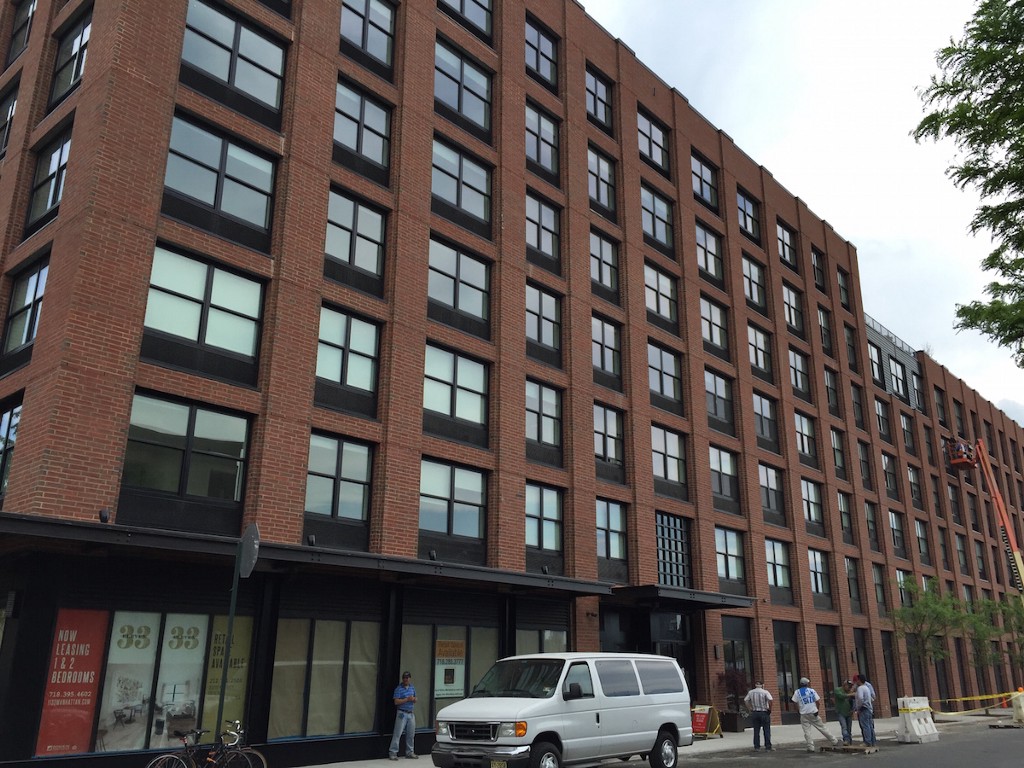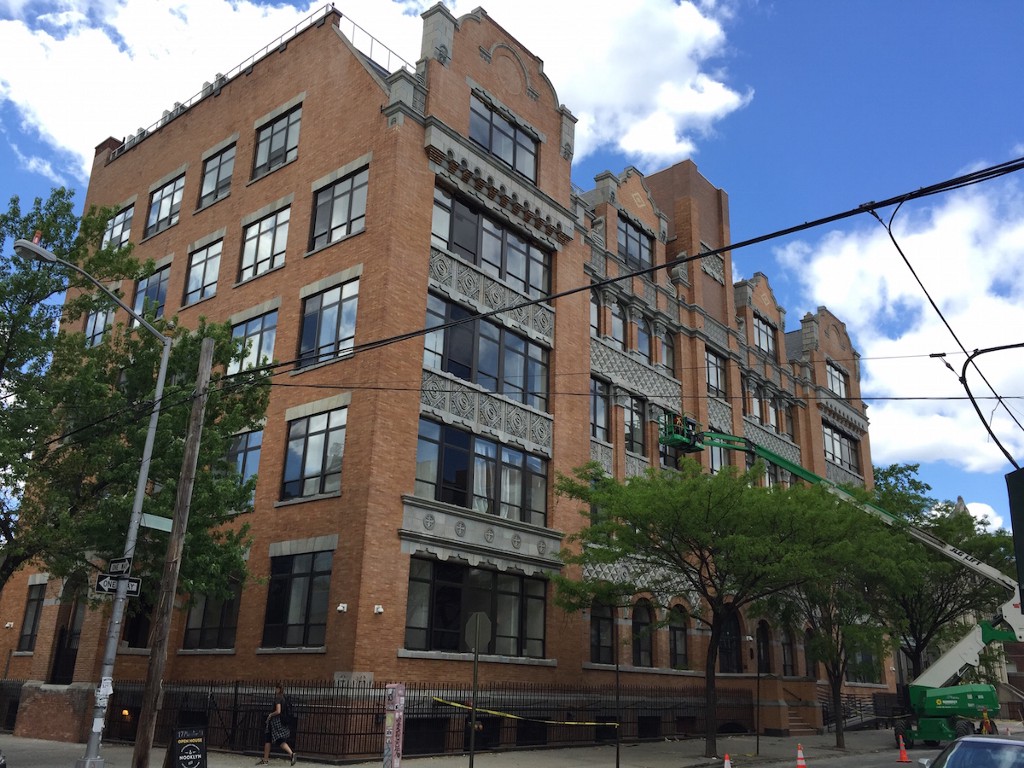The Remodeling of Greenpoint
by Brendan O’Connor

1133 Manhattan Ave, N713
• $5,042 per month
• 2 bedrooms, 2 bathrooms
• Nearest subway: G train at Greenpoint Avenue
In 2005, the New York City Council rezoned much of north Brooklyn’s waterfront, which had, until that point, been a predominantly industrial area. “The rezoning,” the New York Times wrote that May, “would transform the long-crumbling waterfront into a residential neighborhood complete with 40-story luxury apartment buildings, shops and manicured recreation areas.” And so it has, at least in Williamsburg. To the north, Greenpoint has largely yet to feel the direct effects of that landmark plan. Over the course of the next ten years, however, that is all going to change: planned new construction will add eight thousand new apartments in the next decade, the New York Post reported in March.
On Tuesday, a tall white man wearing headphones and a t-shirt emblazoned with a black-and-white image of a young black child framed by the words, “Brooklyn Before Gentrification” walked past one of those buildings, found at 1133 Manhattan Avenue. In marketing materials, the building is referred to as “Eleven33.”
The developer, the Domain Cos., received fifty-seven million dollars in financing towards the eighty-million-dollar development project. “The property will be the first apartment tower in the neighborhood to tap tax credits and low cost debt allocated to developments that include affordable housing and remediate polluted land parcels,”
Crain’s reported in 2012
. “That financing strategy could be increasingly common as more sophisticated builders come to the neighborhood bordered by Newtown Creek, which is a Superfund site.” Nearly sixty thousand people applied for the two-hundred-and-ten-unit building’s hundred and five affordable apartments.
The building, which is quite large, has two entrances. Both are accessible to all residents, Katie Eckel, an agent with MNS, was quick to assure me. There is no distinction between the affordable units and the market-rate units, she said. “They’re all mixed in together.” Asked whether the presence of the affordable units changed the way the building was marketed, Eckel was emphatic. “Not at all,” she said. “People are just concerned with the location. If anything, the market-rate tenants are jealous.”
All tenants at 1133 Manhattan Avenue enjoy discounts at local businesses, like happy-hour specials and ten-to-fifteen percent off at restaurants, Christophe Tedjasukmana, another MNS agent, told me. The building offers Verizon FiOS and each apartment has a pantry in the kitchen. “There are really a lot of condo finishes,” Tedjasukmana said as Eckel sang the praises of the walk-in closet. “Everything a girl could want,” she said. “Or a gay,” Tedjasukmana added.
The building is about eighty percent occupied, Tedjasukmana said, and there are less than two dozen (market-rate) units left; at this point, only two-bedrooms are available. For tenants who sign before May 15th, MNS is offering a month-and-a-half of free rent and no broker’s fee. The views of the East River and Manhattan from the roof — and the northern penthouse terraces — are impressive and, for now, unimpeded. Eleven33 is not directly adjacent to the water, and future developments in the area will stand between the building and the river. “In a few years, it could be a problem,” Eckel said. “But, if you’re renting, you don’t care.”


17 Monitor Street, 5K
• $4,335 per month
• 1.5 bedrooms, 2 bathrooms
• Nearest subway: L train at Graham Avenue
In 2013, St. Cecilia’s Roman Catholic Church in Greenpoint signed over two buildings it owned — a shuttered school and a smaller building — to a developer on a forty-nine-year lease. According to the Real Deal, rent on the properties starts at 1.2 million dollars annually and rises to 3.2 million dollars in the forty-sixth year of the lease.
“The properties have an unhappy backstory, which isn’t the developers’ fault,” the Brooklyn Eagle wrote last April. “After the century-old school closed in 2008, recession put the kibosh on a plan to market the buildings. The pastor, Father James Krische, invited artists to use them — and drew an enthusiastic response.” The school hosted an average of ten film and video shoots every week, the Eagle reported, until two years later when St. Cecilia’s was merged with two other parishes and Father Krische was transferred. “The artists’ days on Monitor Street were over.”
Now, there are sixty-nine apartments in the old, nearly fifty-thousand-square-foot school building at 17 Monitor Street. Although renovations are not quite yet complete — the official move-in date is June 1st — at least one is occupied, and other tenants have negotiated a May 15th move-in. Deposits on twenty-one apartments have been accepted so far.
Many of the apartments occupy old classrooms, Moiz Malik, partner and CTO at Nooklyn, told me. All units come with built-in, Bluetooth enabled speakers. On the top floor, the apartments are lofted — the high ceilings reminiscent of an old basketball gym. In the basement, there is a yoga room. “It’s kinda funny,” Malik said. “Buddhist yoga in a Catholic school.”

110 Nassau Avenue, 3A
• $1,800 per month
• Studio
• ~400 square feet
• Nearest subway: G train at Nassau Avenue
A few blocks north of McCarren Park, an eighteen-hundred-dollar-per-month studio is about seven hundred dollars below market rate for an equivalent apartment in the area. “The landlord could easily be getting way more,” Lotfi Chortani, a broker and the owner of Target Realty Group, said. “But he’s not that kind of a landlord. He’s not greedy.” The studio is small: the current tenant’s bed occupies the width and most of the length of a closet-like space separated from the main living area.
Chortani went on: “He’s got the commercial tenant on the ground floor. He covers his mortgage, and that’s it.” Standing outside, he waved down Nassau Avenue towards Williamsburg’s glittering waterfront. “They used to dump garbage there,” Chortani, an immigrant from Tunisia whose wife grew up in Brooklyn, said. “They would find bodies!”
The current tenant is moving to California for graduate school, so, if you like, you can buy all of his stuff — two years’ worth — and the apartment will be furnished when you move in July 1st.
